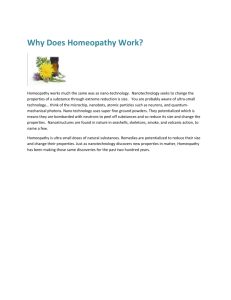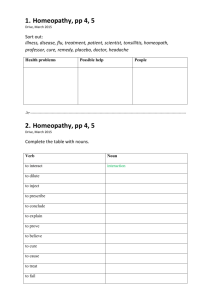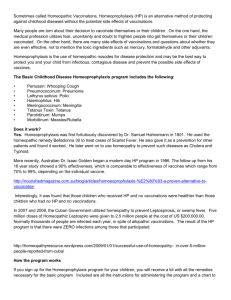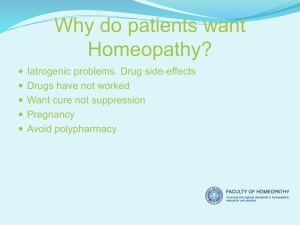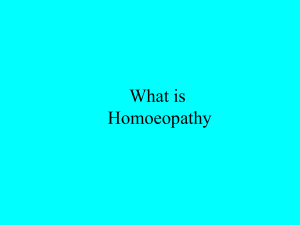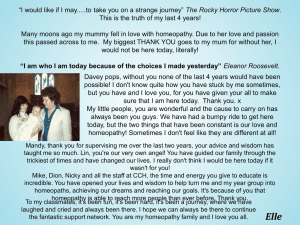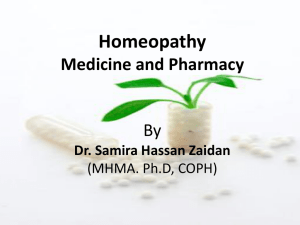The Basic Principles and Philosophy of Homeopathy
advertisement
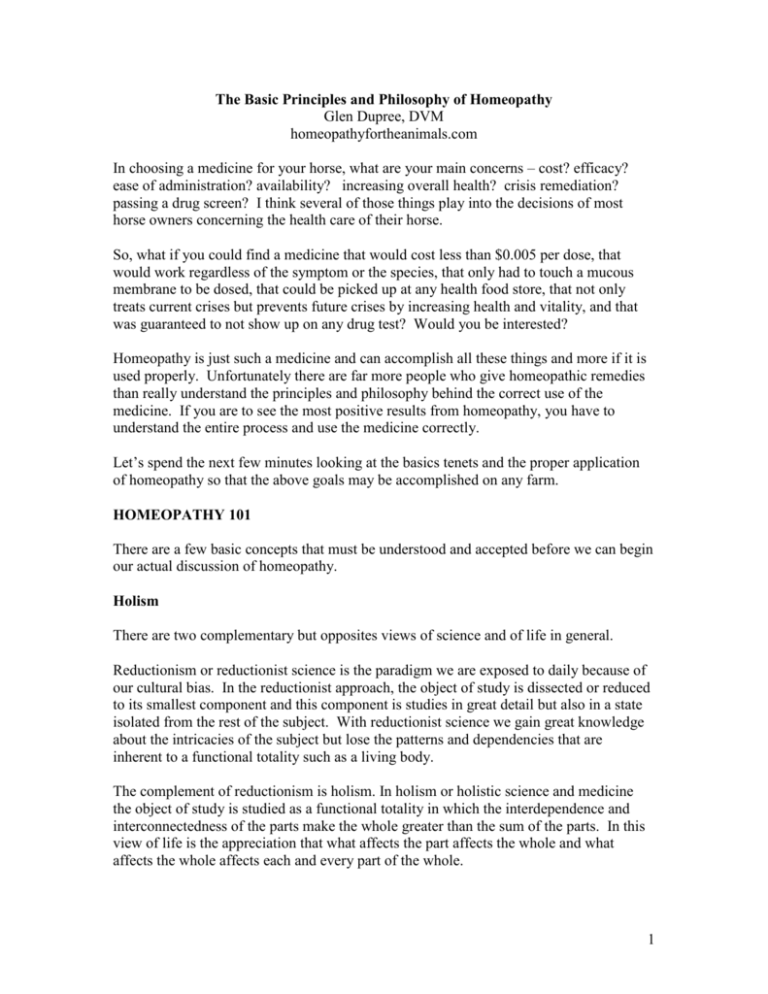
The Basic Principles and Philosophy of Homeopathy Glen Dupree, DVM homeopathyfortheanimals.com In choosing a medicine for your horse, what are your main concerns – cost? efficacy? ease of administration? availability? increasing overall health? crisis remediation? passing a drug screen? I think several of those things play into the decisions of most horse owners concerning the health care of their horse. So, what if you could find a medicine that would cost less than $0.005 per dose, that would work regardless of the symptom or the species, that only had to touch a mucous membrane to be dosed, that could be picked up at any health food store, that not only treats current crises but prevents future crises by increasing health and vitality, and that was guaranteed to not show up on any drug test? Would you be interested? Homeopathy is just such a medicine and can accomplish all these things and more if it is used properly. Unfortunately there are far more people who give homeopathic remedies than really understand the principles and philosophy behind the correct use of the medicine. If you are to see the most positive results from homeopathy, you have to understand the entire process and use the medicine correctly. Let’s spend the next few minutes looking at the basics tenets and the proper application of homeopathy so that the above goals may be accomplished on any farm. HOMEOPATHY 101 There are a few basic concepts that must be understood and accepted before we can begin our actual discussion of homeopathy. Holism There are two complementary but opposites views of science and of life in general. Reductionism or reductionist science is the paradigm we are exposed to daily because of our cultural bias. In the reductionist approach, the object of study is dissected or reduced to its smallest component and this component is studies in great detail but also in a state isolated from the rest of the subject. With reductionist science we gain great knowledge about the intricacies of the subject but lose the patterns and dependencies that are inherent to a functional totality such as a living body. The complement of reductionism is holism. In holism or holistic science and medicine the object of study is studied as a functional totality in which the interdependence and interconnectedness of the parts make the whole greater than the sum of the parts. In this view of life is the appreciation that what affects the part affects the whole and what affects the whole affects each and every part of the whole. 1 The difference in these two views of science is the difference between studying the inventory on an automobile part store and driving a fully functional automobile. This translates in medicine as the difference between conventional medicine where the patient is reduced to a particular tissue or organ to be treated by a specialist and where disease is reduced to a static diagnosis fixed in time versus holistic medicine where the patient is treated as a functional whole where there can be no specialization (since what affects the part affects the whole and what affects the whole affects each and every part) and where the concept of disease is dynamic and expands to include those trends and patterns of symptoms through all the systems of the body through time. In holistic medicine, “disease” is not a static event but an imbalance of the life force that manifests in the physical symptoms of the diagnosis. Simply suppressing the symptom removes the end result of disease but does not address proximal cause. The difference in these approaches is that if the conventional doctor or veterinarian removes the symptoms of today in their particular area of expertise then they have done their job, regardless of future symptoms and illnesses in the patient. In holistic medicine the goal is to restore balance and harmony to the entire system so that, not only are the issues of today resolved, the patient is left healthier, more resistant, and more resilient into the future on all levels (and actually into future generations for breeding stock). Acute and Chronic Disease Another concept that differs between conventional medicine and homeopathy is the concept of acute and chronic disease. On the conventional side, a “disease” is acute for the first hours, days, or weeks, depending on the artificial and arbitrary timeline assigned to the particular process. If it lingers past this timeline, the disease is termed chronic. The distinction between acute and chronic is based solely on duration of symptom. In homeopathy, the difference between “acute” and “chronic” has nothing to do with time. The difference here is determined by dynamic origin. The difference between an acute and a chronic disease here is in the nature of the influence that disrupts the life force/animating dynamis. An acute disease has its origins external to the body. An acute disease originates in and is caused by external stressors that are not dependent on individual susceptibility. The insult that results in acute disease is noxious enough to overcome individual resistance. In short an acute disease arises from trauma, poisonings, or epidemic contagions where nearly every member of the population exhibits similar symptoms. An acute disease will resolve spontaneously in time, even without treatment, without leaving any lingering untoward changes in the patient except for perhaps structural pathology (ie, a fracture bone that is not properly set and heals askew). We treat acute disease to speed recovery, lessen suffering and death (one form the spontaneous 2 resolution can take in extreme acute disease is death), and to minimize economic impact. Since there will be spontaneous resolution and since the acute disease is the result of influences outside of the body, an acute disease process is easier to treat and is more forgiving of improper treatment. Chronic disease, on the other hand, is displayed in the continuum of symptoms through the life of the patient that are not from trauma, poisonings, or epidemic contagions. Its origins are in the inherent imbalances of the body and are dependent on and reflective of individual susceptibility. Chronic disease may wax and wane over time dependent on external stressors. External stressors may elevate chronic disease from latency to crisis proportion but are not the cause of chronic disease. Chronic disease is on-going, without spontaneous resolution, regardless of external influences. Since chronic disease is inherent to the body, since it is ongoing without the benefit of spontaneous resolution, and since the effects of therapeutic interventions will be reflected in to the future of the patient, treatment of chronic disease is unforgiving of less than curative treatment. A truly curative therapy in chronic disease must be capable of restoring balance and harmony to the life force at all levels and leaves the body less sensitive to/more resistant to noxious external stressors into the future. Appreciating the dynamic differences in acute and chronic disease at this level will dictate our therapeutic protocols and our expectations for the patient into the future and will make our assessment of our therapeutic interventions much more comprehensive. Components of a Complete Medical System In any complete medical system there are two necessary components – hygiene and therapeutics. In homeopathy the term hygiene takes on a broader definition and a greater significance than simple sanitation. Hygiene is eliminating or minimizing any noxious external influences that may be promoting or worsening the display of symptoms in our patient. Hygiene should and does include consideration of such factors as nutrition (a speciesappropriate variety of fresh and whole foods, including water, fed in a speciesappropriate manner and on a species-appropriate schedule), digestion (it really does not matter much what the horse is being fed if it is not capable of digesting and absorbing the nutrients in the feed), special needs supplements, housing, equipment and tack, infrastructure, handling, social interaction, work and production levels (within the physical and physiological bounds of the individual), preventative and therapeutic medical interventions (vaccinations, supplements, body work, etc), grooming, exercise, and human interventions (riding, shoeing, hauling, selection of tack, etc). The goal of hygiene should be to put the patient into a world as normal for the species as is possible within the bounds of domestication and the limitations imposed by the 3 animal’s purpose within domestication. Most of these aspects of hygiene are addressed by the competent and conscientious horseman as part of the day to day responsibilities of horse ownership but without the appreciation of their importance in the over-all health care of the horse. Based on our discussion of the true nature of acute disease and the crises of chronic disease, then it follows that the better we are at providing proper hygiene, at avoiding these noxious external stressors, the fewer incidences of acute disease we will see and the fewer times we will see chronic disease elevated to crisis proportions. Because of the level of human involvement and that impingement on the horse’s world, there is no species that benefits more from correct hygiene than the equine species. Many, if not most, of the medical problems we consistently see in our horse population would benefit more from the correction of human deficiencies and human imposed programs than from any pharmaceutical intervention. Still, because of the dynamic and on-going nature of chronic disease and because we will never be able to eliminate all the noxious stressors in our imperfect world, simply correcting hygiene will not eliminate ill-health. We will continue to see our horse companions exhibiting the symptoms of dis-ease (although at a lesser level and with better response to intervention than had we not previously corrected hygiene to the best of our ability). It is at this point that we need a therapeutic option, a medical or surgical intervention that will help us eliminate the production of symptoms at the level of proximal cause and not at the end result of the symptom being produced. We need a therapeutic option that will restore balance and harmony to the life force and will leave our patient healthier and more vital into the future while quickly and efficiently removing the symptoms of today. Homeopathy I admit that I come to this point in the paper with a heavy bias. In evaluating other forms of therapy on the basis of efficacy, efficiency, economics, ease of administration, and elegance, few, if any, that I have found match and certainly none exceed homeopathy. When used properly I have found no other approach to medicine that is as broad or as consistently curative, that can be used regardless of species or circumstance, or that can yield the depth and duration of results as can homeopathy. For me the progression of thought and reasoning through the 4 rules of homeopathy is flawless. If you follow these four rules, you can treat any symptoms, in any species, under any circumstance, without having to change or make exception. And since in homeopathy we treat the patient and not the diagnosis, it is incredibly liberating and empowering compared to the conventional approach to medicine where so many diagnoses are “untreatable” leaving the patient “incurable”. 4 Ultimately homeopathy is satisfying because it works with nature and with the natural tendencies of the body in effecting a cure. The Four Rules of Homeopathy 1. The Law of Similars: Similia Similibus Curentur or Like Cures Like This is the law that sets homeopathy apart from all other forms of therapy. In the purest form, this law says that if a substance given in large quantities can produce a set of symptoms, it will also be curative in a patient exhibiting similar symptoms if given in minute quantities. A substance can cure because it is capable of causing. This seems counter-intuitive, giving a medicine that is capable of causing similar suffering as the patient already has, but as you come to understand the homeostatic tendencies of the body, the primary and secondary responses to any medicine based on homeostasis, and the competitive nature of similar dynamic influences on the life force, then homeopathy and the law of similars comes to make perfect sense. There are also explanations for this phenomenon to be found in the science of hormesis. Unfortunately a fuller explanation of either of these would take more time than has been allotted here. For now in lieu of the fuller explanation, the homeopathic remedy is chosen and administered to the patient because it is capable of causing symptoms similar to those being caused by the patient’s natural disease with the goal of removing the entirety of the patient’s dis-ease on all levels. 2. The Use of Proved Medicines If we are going to prescribe and administer a medicine based on the law of similars, if we are giving a medicine that is selected because it can cause symptoms similar to those of the patient, we must first know what symptoms the medicine is capable of causing. This knowledge comes from the process of “proving” the medicine. In a proving, a group of healthy individuals are brought together and are given the medicine in sufficient quantity and repetition that they begin to produce symptoms. These symptoms are collected and recorded as if they happened to a single individual so that all the symptoms through all the systems of the body that this medicine is capable of causing are documented. A proper proving gives knowledge of the medicine mentally, emotionally, functionally, physically, pathologically, and through all the systems of the body so that there is no dichotomy between psyche and soma, mind and body. This information is recorded in books called materia medica. Materia medica are essentially dictionaries of the remedies systematically telling the symptoms the medicine is capable of causing. These books can be as involved as the 10 volume Hering’s Guiding Symptoms of Our Materia Medica to the more concise volumes such as Clarke’s Dictionary of Practical Materia Medica 3 volume set to the pocket sized first aid books and emergency manuals. 5 3. The Use of the Totality of Symptoms Since homeopathy is a holistic medicine, since what affects the part affects the whole and what affects the whole affects each and every part, then it is reasonable to assume that every symptom produced is but one aspect of the same process – the totality of the patient’s dis-ease. In an acute disease, all the symptoms of the event are taken into account (since an acute disease is actually external to the patient and has a finite duration). In chronic disease all the symptoms of the patient, both current and historic, are taken into account (since chronic disease is inherent to the patient and is a continuum through time). These symptoms produced by the patient are matched in their totality to a remedy capable of causing similar symptoms. To make this task simpler, there are books called repertories which are basically lists of symptoms arranged by anatomic region along with the remedies that were proved to have caused that particular symptom. By looking up the pertinent symptoms of the patient in the repertory, a working list of potential remedies for the patient is developed. This list is then taken to the materia medica for study and for the selection of the remedy that best matches the totality of the symptoms. A repertory may be one of the huge modern works like Synthesis, the smaller but time tested Kent’s Repertory, or combined with a materia medica in one of the first aid or emergency manuals. 4. The Use of a Single Dose of a Single Remedy Homeopathy is an exact science that only introduces a single variable at each step so that the outcomes can be fairly evaluated. In chronic disease, hygiene is first corrected (in acute disease the correction of hygiene may eliminate the acute disease process without the need for therapeutics) unless the patient is dying in front of you. Then, when it comes time to treat, the existing symptoms must be from the naturally occurring disease and not from external stressors. Since we are treating a single patient in its totality, and since we are matching all the symptoms of the patient to a remedy capable of causing the same totality of symptoms, there is the need for only a single medicine. When this single dose of the single medicine is given, that is the only variable, the only change in the patient’s world at that time. Subsequent changes in the patient can then be related back to this dose. If the change is curative, there is no need to change remedies. If it is less than curative, then you know to look for a better suited remedy. Once a curative reaction is established, the remedy is only repeated in single doses as often as necessary to maintain the response. This timing will vary with the remedy, the vitality of the patient, and the dynamics of the disease process. 6 If the response is less than curative, then the remaining and/or new symptoms of the patient will be the guide to the more appropriate remedy. It is by assessing the changes in the patient that the homeopath knows the correct next step. If multiple remedies or multiple therapies are used simultaneously, it is impossible to evaluate the patient’s response to any individually in chronic disease or to assess the long-term impact each will have on the patient. Treating acute disease is more forgiving of a more “shotgun” approach. The nuances of homeopathic therapy come with potency selection, second prescriptions, assessment of remedy action, and more complex analysis techniques but, by following these 4 rules, you can treat any patient homeopathically. Making the Transition to Using Homeopathy Generally, for those new to or skeptical of homeopathy there needs to be a transition process so that you can gain confidence by seeing the remedies work. This is best done on the relatively more simple acute diseases or the crises of chronic disease. In either of these cases, the symptoms are overt and well-defined, the action of the remedy quick, and the response of the patient clear. On most farms, there is a common or recurrent malady – an infection, an abscess, a founder, etc – that has a common treatment protocol already established. With this preexisting treatment protocol, the horse owner knows what to expect from his or her stock for the given condition. There is experience with this “disease” and with this treatment. With this experience is an expected course of response and expected outcome. To begin using homeopathic remedies, you do not necessarily have to put aside those former treatments. Use them as your baseline for the evaluation of the homeopathic remedy. The protocol is established and the outcomes anticipated so that if we now add a homeopathic remedy, we still have only one variable. If the resolution of the disease process is shorter, smoother, with less suffering, or easier with the homeopathic remedy than without, then we can attribute that difference to the remedy because that is the only thing that has changed from the previous protocol. With repeated verification of this improved result, you will become more confident in homeopathy so that you will reach for the remedies first and use the old protocol for back-up. Then eventually, as you become better at prescribing the remedy and following the patient’s lead in the cure, you will no longer have need of the old, and usually more complicated, protocol. Then you are ready to start treating chronic disease in its subtle forms and averting the next crisis. When the hygiene on the farm is correct and the treatment of disease is curative to the depths of the dynamic root of the disease, then you are truly practicing preventive medicine and minimizing crises. 7 Glen Dupree, DVM, CHV, has practiced veterinary homeopathy for the past 15 years. He maintains an active teaching, writing, and speaking schedule and has served as a mentor on Dr. Pitcairn’s Professional Veterinary Homeopathy web list. Dr Dupree’s first book, “Homeopathy in Organic Livestock Production” has recently been published and is available on his website. His current projects include a series of webinars based on veterinary applications of homeopathy. For those looking for a truly holistic approach to veterinary health care, Dr. Dupree is available for consultations. www.homeopathyfortheanimals.com Dr. Dupree is conducting a workshop on Homeopathy for Horses in Cornville, AZ on September 11-12th. Contact Lisa@naturalhorsetalk.com or 928-634-5797 for more info. Space is limited so sign-up early. 8
